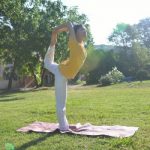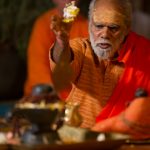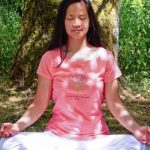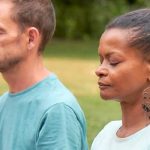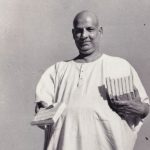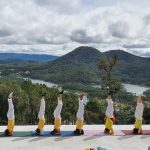 Building Global Peace from Within
Building Global Peace from Within
by Srinivasan
Peace is the happy, natural state of man. It is his birthright. War is his disgrace…. Peace, to be lasting and constructive, must be achieved through God. There can be no peace without the Lord or God. Root yourself in peace or God. Now you are fit to radiate peace. – Swami Sivananda
 State of the world
State of the world
The absence of peace poses the greatest challenge for modern civilisation. As individuals we face an epidemic of suffering minds out of balance in a world of constant overstimulation driven by power, pleasure, fear and hatred. As a civilisation we are intent on war, with over forty wars going on consistently for years; and with the capacity of MAD (Mutually Assured Destruction), it is only time before a proxy war turns into a full-blown world war clash of empires that leads to global self-destruction.
Peace is within
Yoga practice offers not only a general attitude of peace, recognising unity in diversity, but offers a vast collection of specific antidotes to the multi-layered conflicts of modern life. Lack of peace is suffering which incites the escalating spiral of more conflict, and more suffering. Yet, even temporary peace gives temporary repose and happiness; and each time we recognise the source of peace within, the habit of turning to peace rather than power of arms is strengthened. As direct experience through yoga practice, peace becomes the inspiration of our faith, and supreme peace shines on the horizon as the goal of life.
Yoga Masters
The great yoga masters have shown by their examples that by making peace their ‘bottom line’, the seemingly never-ending suffering of drama in daily life is transformed by the direct experience of peace, replacing such distractions as attachment to material wealth and comfort, conspicuous consumption, sensual pleasure, negative emotions, fear, and insecurity. Yoga simply put is a practice of ‘attach and detach’ – attach to God, to the good and beautiful; and detach from dysfunctional habits, attitudes, and emotions.
Through the self-transformation that is the fruit of sustained yoga practice experienced as inner peace, we build faith through experience. With this faith the paradigm of the possible is expanded, and we can envision physical and mental health. As mental health is the basis of healthy relationships, working on peaceful relationships becomes the next step to our yoga practice.
Just as the practice of hatha yoga gives us the experience which builds not only physical and mental health, but the faith that this health is even possible, the practice of yama and niyama (the ethical foundations of yoga), karma yoga (actively caring for the world and others), bhakti yoga (devotion that allows us to rest in God), and jnana yoga (the philosophy of unity in diversity), we learn to cultivate respect and peace where there was fear, prejudice, anger and hatred.
Healthy relationships
Once we truly begin to see that healthy relationships transform our lives with meaning and love, that experience-based faith can be brought to our communities, corporations and nations. With a vision of peace, compassion, unity and sustainability as the natural outcome of healthy relationships, the focus of Western civilisation on power, pleasure and profit is seen as the obstacle to peace and happiness, rather than the goal. World peace is not only possible but the condition for the survival of life as we know it on the planet.
World family
The foundation of world peace is laid by first acknowledging and honouring the whole world as family. Through enabling practitioners to experience inner peace, yoga empowers people to be courageous and humble messengers of peace. The practice of yoga provides pathways of health, integrity and resilience to a chaotic world out of balance. Yoga as the quest for peace realigns our energy, attitude, priorities and relationships, as well as providing the knowledge and the discipline to develop the skills and clarity necessary to live according to our ideals.
The Sivananda Yoga Vedanta Centres, in the tradition of Swami Sivananda, practise a yoga of synthesis, which integrates yoga’s rich culture of a multifaceted approach to mastering body, energy, mind and attitude, with knowledge, understanding, and mystical experience of peace. Hatha, raja, karma, bhakti, and jnana yogas each offer skillful strategies for tapping inner peace and efficiently living peace. Before we examine each of these strategies, we need to understand the obstacles to peace that our yoga practice empowers us to overcome.
How to Engage in Peace
- Step out of denial. Human behaviour is destroying the world with global warming, war, pollution, exploitation, destruction of natural resources and diversity of life, starvation, waste.
- Ask the karma yoga question: How can I help? Practise compassion: serve, love, give, purify, meditate.
- Recognise the vanity of all ’isms—sexism, racism, communism, capitalism, nationalism, imperialism, colonialism, egoism are all enemies of peace. Stand up against violence. Meet hatred with love, fear with courage. Maintain dharma with humility and non-violence.
- Find inner peace. Do sadhana to find that peace. Spiritual practice is service because it provides the energy to work. Service is sadhana as it purifies the heart and builds virtue.
- Honour the sacred; honour the Commandments (tapas); Know God (swadhyaya); Love God unconditionally (ishwara pranidhana). Be pure (saucha); Be happy and grateful (santosha). To remember the divine name in daily japa is the easiest way to practise all of these niyamas.
- Meditate. Meditation is bathing in the light of the sacred. Make meditation the background of your asana and pranayama and service.
- Promote peace. Peace is possible. War is criminal. Protect the oppressed. Protect the planet.
- Model sustainable living. Recycle to create zero waste. Only a net zero carbon footprint will insure a habitable planet for future generations.
- Practise charity, public service, activism, education, sustainable technology.
- What is the purpose of life? What does it mean to be human? We are asleep. Wake up and live responsibly and compassionately.
Each of the yogas is guided by an understanding of the qualities of nature that influence our reactions, perceptions, and motivations. Classical yoga philosophy recognises three main qualities or gunas, which are the very fabric and movement of nature. These qualities, when guided by the integrative intelligence of Nature, are observed as instinct, or genetic tendencies, masterly woven into the intricate web of life.
The changes of the seasons, the stages of life, the distinctive characteristics of all organisms, the physical laws, chemical atomic structure, the movement of the planets, stars and galaxies, birth, growth, decay, and death, are all the play of the gunas. Skill in yoga is measured in our ability to live in harmony with these changes, and transcend the drama the untrained mind creates reacting to the natural changes of the world.
Three gunas
Of the three gunas, sattva holds the key to transforming suffering into peace. The sattvic mind is a quiet mind – peaceful, aware, and compassionate, seeing unity and respecting diversity, loving and attracted to truth or dharma. Rajas and tamas are the bipolar pathways of the mind. The rajasic mind is driven by greed, lust, anger, jealousy, and vanity. It objectifies the world into emotionally charged pieces – likes and dislikes, superior and inferior, worthy and unworthy.
The world is to be possessed and dominated. Happiness is conditional on possessing, consuming and controlling those objects of desire; and escaping everything that the mind finds disagreeable or painful. The tamasic mind is depressed. It is lost in negative emotions of fear, hatred and despair. Not only is the mind distracted by rajas or lost in the suffering of tamas, it habitually reacts to that suffering with instinctual self-protection, externalising the suffering, lashing out at the world in violence, prejudice, lust, greed and jealousy.
Blinded by vanity, it has no awareness of the suffering of others or the damage that it is wreaking upon the world in which it dwells. If pleasure, power, and profit are the bottom line, the bipolar rajasic and tamasic dramatic suffering of the mind is aggravated by rajas, and/or beaten into the despair of tamas. If peace is the focus, then the mind enlightened by truth or sattwa, gravitates towards the peace of silence. Yoga is the path to sattwa. In cultivating sattwa, peace itself becomes both the daily reference and the supreme goal.
Modern civilisation
In contrast, modern civilisation, not knowing peace or even how to truly relax, seeks happiness in a dysfunctional, superficial lifestyle. Selfish vanity manifests as the three universal defects of the human mind – impure attachments (mala); agitation and distraction (vikshepa); and ignorance of the true Self (avarana). The three gunas are always at play in nature, and the human mind is no exception. However, through continuous practice, sattwa or purity, can become the dominant guna or quality.
As the mental experience of tamas is suffering, with the practice of awareness of that state, and skill in various yoga practices, tamas can be overcome. Similarly, the agitated, desire-driven rajas can be transformed into sattwa. Because the fruit of practice becomes increasingly more enjoyable and natural, yoga is its own reward. With skilful discrimination to attach to the good and the beautiful and detach from habitual suffering, morality becomes a path to freedom rather than imposed external authority.
Add a little humour and humility, and the classic yoga practices and positive philosophy can tame and channel our energy. Emotions are transformed into blissful devotion, and attitude positive full of light. Finally, yoga promises that when the mind attains absolute silence in peace, it becomes a pure mirror reflecting the universal, unchanging reality and final liberation from suffering attained.
Yoga turns the mind inwards
Yoga turns the mind inward in introspection, self-discipline, meditation and realisation of the pure mind behind the gross material mind. Yoga guides the practitioner through five progressively peaceful states of mind:
1. Mudha – the dull, cloudy, low energy state of mind. Depression. Tamasic energy.
2. Kshipta – agitated monkey mind, that is driven, reactive, full of drama that lacks focus. Anxiousness, lust, passion, fear. Rajasic energy.
3. Vikshipta – gathering state of the mind. Concentration with effort. Abhyasa (continuous practice) and vairagya (letting go of distraction). Rajas is transformed into sattwa.
4. Ekagrata – one pointed meditation, the fruit of practice of abhyasa and vairagya, with duality – subject and object. Sattvic mind.
5. Niruddha – the waveless state beyond thought. This is the goal of yoga, asamprajnata samadhi. Pure consciousness transcends the gunas and the mind.
Working through the stages of yoga, we are given the tools to transform depression, anxiety, distraction and drama-filled suffering, to the pure mind and finally attain supreme peace.
Pranayama (mastery of the subtle breath or prana) is a powerful practice of awakening from mudha, directing kshipta by calming the breath and concentration on inner peace, and gathering the scattered rays of the mind (vikshipta). The subtle work of pranayama is pratyahara (abstracting the mind from emotionally reacting to sense stimulation) and dharana, (concentration on the breath and mantra), turning the mind inwards to focus on baseline of inner peace beyond the noise and distractions of the mind.
This baseline of peace becomes the foundation for progressively deeper meditation and the samadhi or superconscious realisation. All intuitional knowledge is accessible with a quiet, peaceful mind. Yoga shows the way, and offers the experience of peace incrementally, empowering, balancing, and freeing the practitioner from suffering, step-by-step. At each step faith is deepened through progressive experience of peace.
Develop positive habits
Positive physical, emotional, intellectual, and spiritual habits are developed. Tamas or darkness is gradually purified from the mind, and rajasic or selfish desires are transformed into healthy desires, and eventually into pure sattva or peace. The practitioner not only becomes more self-confident and aware, but is also more comfortable with and aware of others. Peace is not only a personal practice, but something that can be shared in each and every interaction with the world.
The teaching of yoga is a vast culture of peace that nourishes the practitioner, who becomes aware of suffering, then uses that awareness to transform it into light or sattwa. The ignorance that is the root of suffering is universal. Through karma yoga, one realises that helping others is really helping oneself. Then yoga becomes a mission of peace to be realised and shared. Conflict and war, no matter what the relationship – friend, family, neighbour, or enemy, is failure. The inner resolution, as well as the external resolution of conflict, becomes the core sadhana, or spiritual practice which informs all other yoga practices.
Living Peace
Each transformation of conflict into peace is a stepping-stone to a quiet mind and a peaceful world. Every resolved conflict, whether within ourselves, with our loved ones, co-workers, nation or on the international stage, is an expression of respectful ‘skill in action’. To advance in yoga is to advance in peace by living peace. Life is sacred and glorious, as the quest for and the realisation of love, peace and wisdom. Ultimately, intuitional knowledge is the key to finding not only inner peace, but transforming conflict into peace. In a conflict situation there are always three ‘truths’: my truth, your truth, and the truth.
The power of intuition allows us to step outside of our vain attachment to emotion and perspective and to hear compassionately the opposing perspectives, and to renounce both in search of the truth. But you do not need to attain the highest intuitional realisation of truth to practise truth. Every aspect of yoga practice is becoming more skilful in truth. Peace is a sign that we are getting closer to the truth, both personally, and in our understanding of the world.
Each day offers us an opportunity to engage in a world that is deprived of peace, to grow in peace, and become a messenger of peace. This does not mean to run away from the world, but to build our strength—physical, energetic, emotional, intellectual, and spiritual, to spiritualise ourselves and all of our relationships. Yoga is transformation. Hear the call of peace, of dharma, of truth and let your practice tune you to become an instrument of peace.
Srinivasan, Acharya – Spiritual Teacher andvLineage holder, US East Coast and Chicago
email [email protected]





